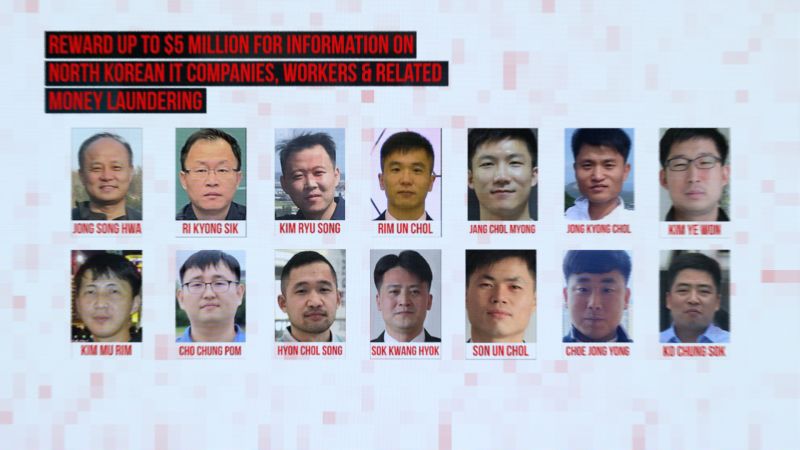Protecting Your LinkedIn Network: Identifying And Reporting North Korean Operatives

Welcome to your ultimate source for breaking news, trending updates, and in-depth stories from around the world. Whether it's politics, technology, entertainment, sports, or lifestyle, we bring you real-time updates that keep you informed and ahead of the curve.
Our team works tirelessly to ensure you never miss a moment. From the latest developments in global events to the most talked-about topics on social media, our news platform is designed to deliver accurate and timely information, all in one place.
Stay in the know and join thousands of readers who trust us for reliable, up-to-date content. Explore our expertly curated articles and dive deeper into the stories that matter to you. Visit Best Website now and be part of the conversation. Don't miss out on the headlines that shape our world!
Table of Contents
Protecting Your LinkedIn Network: Identifying and Reporting North Korean Operatives
The professional networking platform LinkedIn, while a powerful tool for career advancement and business development, is also increasingly vulnerable to malicious actors. Recent investigations have highlighted a concerning trend: the infiltration of LinkedIn by North Korean operatives seeking to exploit the platform for espionage and illicit activities. This article will guide you on how to identify potential threats and report suspicious activity, helping to safeguard your professional network and contribute to a safer online environment.
Understanding the Threat:
North Korean state-sponsored actors are known for their sophisticated cyber operations. Their presence on LinkedIn is a growing concern, with operatives using fabricated profiles to engage in activities like:
- Information Gathering: They may target individuals with access to sensitive information within specific industries, leveraging connections to gather intelligence.
- Recruitment: They might attempt to recruit unsuspecting professionals for malicious activities, often under the guise of legitimate job offers or collaborations.
- Financial Fraud: Fake profiles can be used to perpetrate various financial scams, targeting individuals and companies for monetary gain.
Identifying Suspicious Profiles:
While identifying North Korean operatives specifically is difficult, recognizing suspicious profile characteristics is crucial. Look for these red flags:
- Inconsistent Information: Check for discrepancies in the profile information, such as conflicting job titles, locations, or education history.
- Limited Connections: A profile with few or no connections, especially considering their claimed experience, might be a sign of a fake account.
- Generic Profile Picture: Stock photos or overly polished images are often used to mask the operative's true identity.
- Suspicious Activity: Pay attention to overly friendly or insistent connection requests, especially if they seem out of context or lack a clear professional reason.
- Unusual Language: Grammatical errors or unnatural language use can indicate a profile created by a non-native speaker, often a sign of a foreign operative.
Reporting Suspicious Activity:
If you suspect you've encountered a North Korean operative or other malicious actor on LinkedIn, report the profile immediately. LinkedIn provides reporting mechanisms for suspicious activity. When reporting, include as much detail as possible, such as:
- Profile URL: This is essential for LinkedIn to locate and investigate the account.
- Reasons for Suspicion: Clearly explain your concerns, referencing specific details like inconsistent information or suspicious behavior.
- Screenshots: Include screenshots of the profile and any suspicious interactions you've had.
Protecting Your Network:
Beyond reporting, consider these proactive steps to secure your LinkedIn presence:
- Review your privacy settings: Regularly check and adjust your LinkedIn privacy settings to control what information is publicly visible.
- Be cautious of connection requests: Only accept connection requests from people you know and trust or whose profiles seem legitimate.
- Think before you share: Be mindful of the information you share on your profile and in posts. Avoid disclosing sensitive details about your work or personal life.
- Stay informed: Keep abreast of the latest cybersecurity threats and best practices for protecting your online presence. Resources like the Cybersecurity & Infrastructure Security Agency (CISA) website offer valuable guidance. [Link to CISA website]
By staying vigilant and reporting suspicious activity, you can contribute to a safer and more secure LinkedIn environment for everyone. Remember, your awareness and proactive approach are critical in mitigating the risks posed by malicious actors, including North Korean operatives, on professional networking platforms. Let's work together to maintain the integrity and trust of our online professional communities.

Thank you for visiting our website, your trusted source for the latest updates and in-depth coverage on Protecting Your LinkedIn Network: Identifying And Reporting North Korean Operatives. We're committed to keeping you informed with timely and accurate information to meet your curiosity and needs.
If you have any questions, suggestions, or feedback, we'd love to hear from you. Your insights are valuable to us and help us improve to serve you better. Feel free to reach out through our contact page.
Don't forget to bookmark our website and check back regularly for the latest headlines and trending topics. See you next time, and thank you for being part of our growing community!
Featured Posts
-
 Verizon Email Price Hikes Confirmed For Millions
Aug 07, 2025
Verizon Email Price Hikes Confirmed For Millions
Aug 07, 2025 -
 Jaycee Horn Panthers Cb Involved In Car Accident Sits Out Browns Joint Practice
Aug 07, 2025
Jaycee Horn Panthers Cb Involved In Car Accident Sits Out Browns Joint Practice
Aug 07, 2025 -
 Lewandowskis Power Grab His Increasing Role At The Department Of Homeland Security
Aug 07, 2025
Lewandowskis Power Grab His Increasing Role At The Department Of Homeland Security
Aug 07, 2025 -
 Suspect Arrested Solving The Tennessee Baby Cases Related Murders
Aug 07, 2025
Suspect Arrested Solving The Tennessee Baby Cases Related Murders
Aug 07, 2025 -
 Surprise Former Raiders Coach At Chiefs Training Camp
Aug 07, 2025
Surprise Former Raiders Coach At Chiefs Training Camp
Aug 07, 2025
